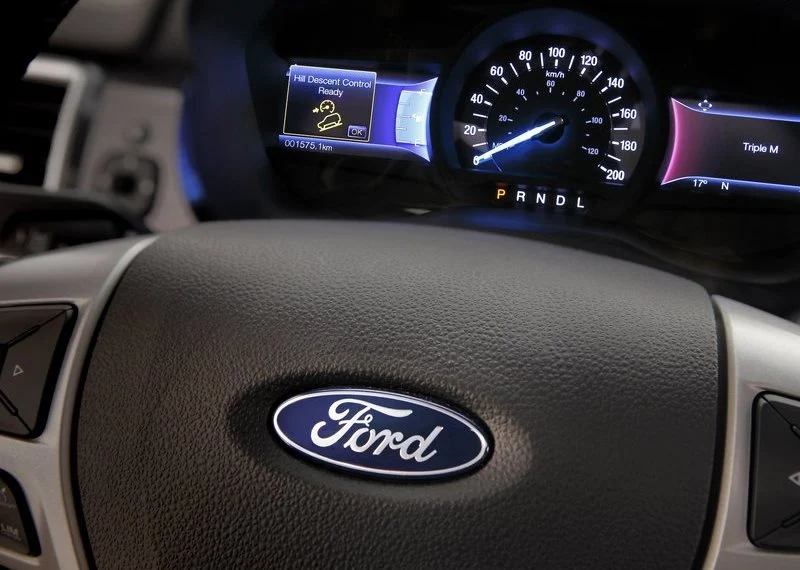Price. $54,990
Like the Ranger that owes much of its popularity to looks that echo those of the rugged and purposeful US-based F-Series pick-up, so too will the Everest’s Bronco-esque lines find favour. Some 16 mm taller and 10 mm wider, the Everest is nevertheless 382 mm shorter than its bakkie
sibling; much of that saving has been shorn from the rear.
While runner boards and a chrome grille and matching door handles are standard throughout
the initial two-model range, top-spec Limited versions gain further on-road presence thanks to the
addition of LED daytime running lights and 20-inch alloy wheels (18-inch units on the XLT).
Aimed at positioning the Everest as more than just a closed-in bakkie, those uniquely sturdy
dimensions, complete with Ford’s global SUV design cues, house standard equipment levels not before seen in this segment. From leather-clad door panels and similarly trimmed seating and facia, to the large, multi-coloured infotainment display and comprehensive multi-function steering wheel, the Everest’s interior portrays an air of sophistication.
Standard across the range, convenience and safety items such as adaptive cruise control and active pre-collision warning systems further this impression. The Limited model gains lane-change assist and blind-spot monitoring, together with electric adjustment for the front seats and tailgate.
Consider too the installation of (relatively effective) noise-cancelling technology in the cabin, together with the aforementioned quality upgrades, and the newest Ford SUV feels much more refined than the Ranger. Still, the setup lends a touch of modern sophistication to the interior package and a comprehensive digital trip computer and voice activated Bluetooth telephony are a boon.
Much of the appeal with vehicles in this segment revolves around the fitment of a third row of seats and, to this end, the new Everest is bound to find favour. From a neatly stowed position in the luggage compartment, each of the two additional seats can be raised upright (electrically in the Limited model) in a 50:50 split.
These supplementary seats not only offer relatively impressive headroom, but with a second row
bench that’s fore and aft (split 60:40) adjustable, the rearmost seats’ legroom can be optimised
accordingly. Climate control vents with separate controls are a welcome inclusion for rear occupants
and, positioned in a variety of useful storage areas throughout the cabin are a number of
12 V power outlets. A total of seven airbags (though no Isofix anchorage points) are included in the Everest package.
Until further notice, the local range consists solely of 4x4 models powered by Ford’s familiar 3,2-litre five-cylinder turbodiesel engine. Boasting 147 kW, this Duratorq motor delivers 470 N.m of torque between 1 750 and 2 500 r/min. Unfortunately, though, the refined and capable drive train is hamstrung by its transmission. The Everest is available only with a torque-converter six-speed automatic transmission that exhibits noticeable lag, particularly from pull-away.
Combine this trait with the Everest’s near 2,5-tonne mass and, even in sport mode on the drive train-management system, on-the-move overtaking manoeuvres require careful planning. All things considered, a claimed 8,2 L/100 km average urban fuel-consumption figure does look somewhat optimistic. Unlike the Ranger’s hydraulically assisted system, the Everest gets electric power steering.
Although somewhat lifeless, especially around the straight-ahead position, the steering nevertheless
allows the sturdy SUV to feel more manoeuvrable both in tight off-road situations and around
town where it works well in conjunction with systems like parking assist (standard in the Limited).
A turning circle of 11,7 metres is a metre tighter than that of the equivalent Ranger 4x4. A further upgrade to the Everest is the addition of coil springs at the rear where the Ranger makes do with leaf items. Combined with the SUV’s additional mass that is focused predominantly over the rear axle, it adds a welcome sense of balance and composure to the package.
This setup also successfully manages to rein in the taller body’s natural tendency to lean laterally in
corners. Standard stability control incorporates a trailer-sway management function, useful considering the Everest’s claimed 3,0-tonne towing capability.
An intuitive Terrain Management System adds further appeal to the package and allows the
driver to seamlessly switch between all-wheel-drive modes. Predominantly rear-wheel driven
in normal driving conditions, an additional sand mode dials in a more aggressive torque transfer
between the front and rear wheels as well as heightened throttle sensitivity in order to maintain
crucial momentum.
A slip detecting snow/mud/grass mode performed impressively as we tackled moist mountain terrain on the local launch, the healthy dose of torque available from low down on the rev range making light
work of steep inclines. A further advantage of a desensitised electrically assisted steering system
in an off-road environment being less kickback through the steering wheel as the front tyres negotiate
a path of least resistance. Low range is engaged via the final setting, rock.
Speed-adjustable hill-descent control, together with an electric locking rear differential, is standard fitment throughout the range, with Ford claiming 225 mm worth of ground clearance (with runner boards fitted) and a class-leading wading depth of 800 mm.
Despite some very obvious flaws associated with ladder-onframe constructions and corresponding solid rear-axle technology – the compromised (read choppy) ride quality being one – these vehicles remain hugely popular.
While the new Everest XLT is refined and sophisticated enough to hold its own (and justify its
$54,990 price premium) against the current top-of-the-range Fortuner, you have to think the
pricing on the Everest Limited, even with its comprehensive standard specifications list, puts
it at the mercy of more premium offerings. The accomplished new Land Rover Discovery Sport,
for example, starts at $54,990 . And that’s before mentioning one of next year’s most anticipated
arrivals, the all-new Toyota Fortuner…
















Post a Comment